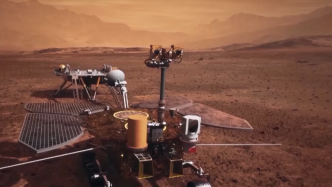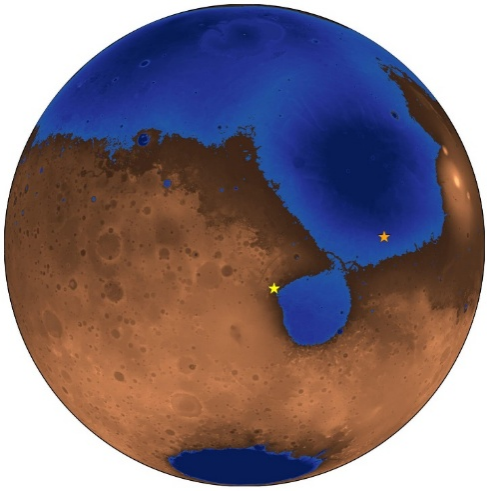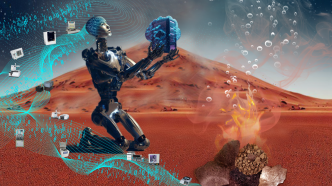
Is there liquid water in the landing area of the "Zhurong" Mars rover? The answer is yes. The international academic journal "Science Advances" recently published a research result on the existence of liquid water on Mars. Based on the observation data of the "Zhu Rong" Mars rover, Chinese researchers discovered for the first time that there are crusts, cracks, agglomerates, polygonal ridges, and banded water marks on the surface of the sand dunes in the "Zhu Rong" landing area. Spectral data analysis found that the surface of the dune is rich in hydrous minerals such as hydrous sulfate, opal, and hydrous iron oxide.
"More importantly, our further research suggests that the water content on the surface of the dunes is not caused by groundwater and carbon dioxide, but by frost or snowfall." On May 4, the corresponding author of the paper, a researcher at the Institute of Geology and Geophysics, Chinese Academy of Sciences Qin Xiaoguang told the Science and Technology Daily reporter.
Whether there is liquid water on Mars has always been the focus of public attention, and it is of great significance for interstellar immigration and understanding the evolution of modern Martian climate. If there is liquid water, it means that Mars may have a suitable environment for survival, and even life.
Past research has shown that early Mars had abundant liquid water. Later, due to the disappearance of the atmosphere, the climate and environment of Mars underwent a major change. The extremely low air pressure and water vapor content made it difficult for liquid water to exist on Mars today, and it can only exist in solid or gaseous form. However, the liquid droplets observed on the robotic arm of the "Phoenix" Mars rover in the United States prove that saline liquid water can appear in the high latitudes of Mars in summer; at the same time, numerical simulations also show that the climatic conditions suitable for the existence of liquid water can appear briefly Somewhere on present-day Mars. "However, there is still no direct observational evidence for the existence of liquid water in the low-latitude regions of Mars, where the temperature is the highest." Qin Xiaoguang said.
In 2021, the "Zhurong" rover carried by my country's Tianwen-1 Mars mission successfully landed on the southern edge of the Utopia Plain, which is located in the low-latitude region of Mars. As of dormancy in May 2022, the "Zhurong" rover has worked for more than 350 Martian days, with a journey of about 2,000 meters, and has obtained a large amount of valuable scientific exploration data. "This provides excellent conditions for the study of the above problems." Qin Xiaoguang emphasized.
Using the navigation terrain camera, multispectral camera and Mars surface composition detector carried by "Zhu Rong", the researchers conducted in-depth research on the microscopic morphology and material composition characteristics of the sand dune surface in this area; Using measured data from meteorological instruments and surface-observed meteorological data from other Mars rovers, the researchers determined that the water-bearing features on the surface of the saline dunes in the region are related to frost or snowfall that occurs when temperatures cool. "Saline sand particles can promote the melting of frost and snow at low temperatures to form saline liquid water. After the brine is dried, hydrous minerals such as sulfate, opal, and iron oxide will cement the sand particles, forming aeolian sand aggregates and even crusts, and the crusts are further dried. Cracks will be formed." Qin Xiaoguang explained that after another frost and snowfall in the later period, traces of liquid water activities such as polygonal ridges and banded water marks will be further formed on the crust.
During the periods of high inclination of the Martian axis from 400,000 to 1.4 million years in the Late Amazonian period, the diffusion and transmission of Martian water vapor from the polar ice cap to the equator led to the occurrence of humid environments in low-latitude regions of Mars. As a result, the researchers proposed that when the Earth's axis is at a large inclination, the low temperature in low latitudes will help to reduce frost and snow, which will lead to the crusting and agglomeration of the surface of the salty dunes, causing the dunes to solidify and leaving traces of liquid water activity. Qin Xiaoguang said that this study fills in the gaps in the ground observation evidence of liquid water in low-latitude areas of Mars, and reveals that modern Mars can still have a humid environment in low-latitude areas where the surface temperature is relatively warm and suitable. This discovery is of great significance for understanding the history of Martian climate evolution and finding a habitable environment, and it also provides key clues for the future search for life. (Original title ""Zhu Rong" Discovers the Existence of Liquid Water in Mars' Low Latitudes")


